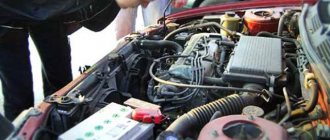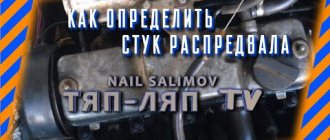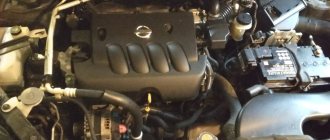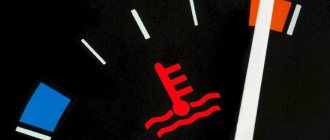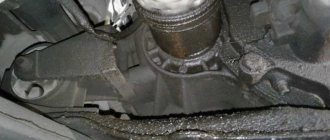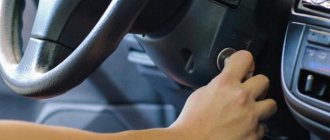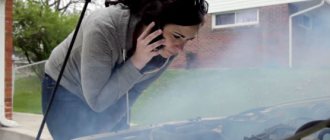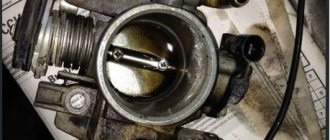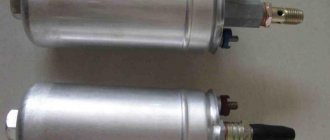The reason for interruptions in engine operation when pressing the brake pedal is most often associated with a violation of the proportions of the air-fuel mixture (AFM). Let's look at how to determine why the engine stalls when braking, shifting to neutral, or suddenly releasing the gas. Let's focus on finding air leaks, checking the vacuum booster and power system.
A little theory that is important to know
Situations when a car stalls when braking happen quite often and this does not depend on the brand of the car.
Two conditions contribute to the emergence of such a situation - the transition of the engine to minimum speed (since the gas pedal is released) and the creation of an additional load on it - the brakes, slowing down the wheels, also create a force on the transmission elements, and accordingly on the power unit.
Despite the fact that the driver stops acting on the accelerator, the power system (injection, carburetor) continues to perform its function - it prepares the air-fuel mixture in the required proportions and quantities, and then delivers it to the cylinders, due to which the engine operates under the above conditions - minimum speed and load resulting from the use of brakes.
But if the proportions of the combustible mixture are violated - it is “lean” or “rich”, then the engine simply will not be able to operate on it.
As a result, the main reason why a car stalls when braking is that the air-fuel mixture does not match the operating conditions.
Noise when braking
High-frequency noise, squealing, and whistling can occur both during braking and, sometimes, during normal movement. The reason is the off-design mode of friction of the friction material on the working surface of the brake disc. Extreme wear on the brake pads and severe corrosion of the brake disc (often on the inside, “invisible” side) may be to blame. It happens that the brake pad lining has peeled off from the base. The list of possible causes continues with contamination of the pads, warping of the disc due to local overheating, improper fastening of the pads in the caliper, left pads or discs, etc.
Diagnostics of VUT
It's very simple. To check the vacuum brake booster, just press the brake pedal several times with the engine off - 5-7 presses are enough. Each subsequent press will be tighter than the previous one. Then, with the brake pedal depressed, you need to start the engine. The pedal should fall under your foot.
If this is exactly the case, then VUT has nothing to do with this situation. He's perfectly fine. If, after starting the engine, the pedal did not fall, but remained in place, then you need to carefully visually inspect the hose, the vacuum booster membrane and other elements of this system.
Hydraulic vacuum hose is one of the causes of failure
To establish a more precise cause of the breakdown, it is necessary to visually inspect the vehicle. It is advisable to diagnose the machine in order. You can start with the vacuum hose. To check its integrity, you must first turn off the engine and then pump the brake pedal 6 times.
During the final action, the pressed brake pedal should remain concave to the floor. After this, you can start the engine. If the vehicle pedal returns to the opposite position, this indicates that the vacuum pump is functioning properly.
If the pedal does not tend to return to its previous position, then you need to look for a leak. Most often, a leak occurs in the area where the hose is fixed to the amplifier or manifold. If liquid is found on the hose itself, this indicates that this is where the cause of the problem lies.
Brake booster pipe
A very important role in the entire structure of the power unit is played by the vacuum booster tube with a valve built into it. With its help, the necessary vacuum is created in the intake manifold of the engine, which ensures the correct formation of the air-fuel mixture. If the valve malfunctions, an increased vacuum occurs in the manifold, which greatly depletes the mixture, as a result of which the car immediately stalls when the brake is pressed sharply. If the hose leaks, excessive air leaks into the manifold, as a result of which the mixture becomes excessively rich, which prevents the normal functioning of the engine. This also makes him go deaf.
Carburetor and fuel pump
On carburetor engines, the air-fuel mixture is influenced by two components - the fuel pump and the carburetor.
Motors with this type of power supply use a mechanical vacuum pump. If a membrane rupture occurs in it, the unit simply will not be able to pump the required amount of fuel.
If the membrane is severely damaged, the pump stops flowing completely, but if the break is insignificant, this will affect its performance.
At high speeds, the amount of fuel pumped may be quite sufficient for the normal functioning of the engine, but at low speeds there will not be enough gasoline (the same “leaning” of the mixture occurs).
The carburetor can cause the car to spontaneously stop when braking due to:
- Incorrect adjustment of idle speed (idle speed);
- Clogged channels of the XX system;
- Malfunction of the XX solenoid valve;
- Air leakage at the junction of the carburetor and the intake manifold.
For the most part, the “fault” of a stalled car when braking is problems in the operation of the idle system, and they can be solved by thoroughly flushing the carburetor, checking and replacing the solenoid valve.
Checking the operation of the fuel pump
Even minor pump failure has a negative impact on engine performance. The car slowed down sharply - the idle speed worked. For a certain period of time, the fuel stops flowing, and then the supply resumes. It is at this time that gasoline may stop flowing and the car stops.
A supercharger is located near the carburetor. You will need to loosen the clamp located next to it a little. Then the fuel is pumped manually. This operation will need to be done several times. The pump performance indicator is the pressure exerted on the finger. If the pressure is high, work will be required to replace the filter and clean the pump.
The car starts on auto start and then immediately stalls.
If the car does not start from auto start, check the car alarm
Also, the car can start from autostart and immediately stall. Don't panic. Perhaps the reasons why this happens are:
If the car starts from autostart and immediately stalls, the cause may be a sharp cold snap outside.
- It's getting cold outside. Fuel does not flow to the injector. Spray a special cleaner into it and start the engine. A low-quality mixture is supplied to the cylinders. Faulty alarm . Worn out or old motor.
When reverse gear is activated
Check the oil level - it may be too high. Inspect the gearbox switch set for reverse speed. It may fail.
I started moving in reverse and the car stalled.
Due to increased pressure, the torque converter may become blocked. The reason is increased oil supply. Start downhill in the neutral position, and then switch to reverse. You will feel whether the torque converter is blocked or not.
Automatic transmission stalls when put into drive
First change the oil in the box. Sometimes the dirt present is the main reason. Or there is a problem with the wear of the solenoids. This requires automatic transmission repair. The second reason is an electronic malfunction that requires diagnostics. Elimination is carried out based on the information received.
Cold car turns off when automatic transmission is turned on
Oil viscosity can only have an effect in very severe frosts. Modern cars take this factor into account. The reason may lie in the speed sensor reading incorrect readings. When the temperature rises, contact is restored and the element begins to perform work correctly.
If no problems are found in the electrical part, look at the mechanics. The box may need to be disassembled.
Influence of unaccounted air
For normal engine operation, the composition of the air-fuel mixture (AFM) should not be much more or less than the stoichiometric composition - 14.7 portions of air to 1 portion of fuel. To adjust the injector open time, it is important for the Engine Control Module to know the amount of oxygen entering the cylinders during the intake stroke. Calculation methods differ in the type of sensors, based on the readings of which the weight of the air charge is calculated.
- An absolute pressure sensor (MAP) paired with an air temperature sensor (ATS). The ECU fuel maps contain the flow area of the engine intake system. Based on the vacuum level in the intake manifold and the air temperature, the engine control unit can adequately calculate the mass of the fresh air charge.
- Mass air flow sensor (MAF). The sensor is based on a heater installed in the intake tract after the air filter. The heater temperature is maintained at the specified level. The stronger the airflow, the more current is required to maintain the temperature of the heating element. By measuring the current, the ECU calculates the amount of air entering the intake tract.
If the actual amount of air entering the cylinders is greater than the calculated value calculated by the ECU based on the readings of the mass air flow sensor, the composition of the fuel injection system will be disrupted. Therefore, the engine stalls when the brake pedal is pressed if there is a leak in the vacuum system.
The speed drops when you press the brake: possible causes, solutions and recommendations
A car is a multifunctional system, where the coordinated and synchronized operation of all mechanisms and each component separately is important. Various failures and breakdowns of at least one of the parts may lead to violations of the clear algorithm of operation of other systems. You can often encounter a situation where the speed drops when you press the brake. This problem is often addressed to auto mechanics. If during braking the speed suddenly begins to fluctuate, you should not wait until the car stops. Soon after this, the engine will begin to vibrate violently and stall. By the way, the problem is relevant only on gasoline engines.
Reasons for interruptions
- Insufficient fuel pressure. Loss of fuel pump performance, malfunction of the bypass valve, clogged coarse and fine filters lead to a decrease in fuel pressure and the appearance of inertia in the fuel supply. Therefore, from the moment the fuel pump is turned on and the injectors open, enough time may pass for the revolutions to drop below the threshold values. In some cases, due to lack of fuel, the car stalls or jerks.
- Contaminated or faulty injectors. Due to deposits and soot, fuel atomization is disrupted and, as a result, the completeness of combustion of the fuel injection pump. But a much more serious problem is a hanging injector, which does not close completely and allows gasoline to pass through into the cylinders. In this case, the car stalls in transition modes due to over-enrichment of the mixture.
- Worn or dirty idle air control. IAC is extremely important for stabilizing idle speed and regulating the amount of air entering the intake when the throttle valve is closed. If the electric motor of the regulator is worn out, or the movement of the rod is difficult due to carbon deposits, the engine may stall when the gas is suddenly released or powerful electrical consumers are turned on.
- Dirty throttle valve. Oil deposits and carbon deposits not only reduce the cross-section of the compensation gap laid down by the engineers, but also lead to jamming of the throttle valve.
Throttle valve
The reason the engine stops when braking can be the throttle valve if it is clogged with residues of low-quality gasoline or sediment formed in the tank over years of operation. This malfunction leads to imbalances in the formation of the fuel-air mixture, the spark plugs of a gasoline engine are flooded, the spark disappears, and the car stalls. Sometimes it happens that the damper is clean and fully operational, but the problem still makes itself felt. In this case, testing of the TPS (throttle position sensor) is required.
Diagnostics is carried out by a specially configured tester. The device connection block is disconnected, one end is grounded to the body, the other is connected to the sensor. When the engine is turned on, the device should remain at zero, taking into account that the operating voltage in the electrical system is 12 V. If the device shows readings other than zero, you need to replace the TPS and test the system again.
An injection engine may stall during braking due to burnt injectors. At this moment, due to overloads, they do not have time to close in time, and fuel floods the spark plugs, preventing the spark from appearing. To get rid of the problem, you need to go to a specialized service station where injectors are cleaned. The most common method is washing in special active substances with immersion in an ultrasonic bath.
The reason is the fuel pump and fuel filter.
An equally common reason for a car stalling during heavy braking is, according to statistics, a malfunction in the fuel pump or a clogged fuel filter. It is as a result of this that the engine does not receive enough fuel to operate, so it stops and the car suddenly stalls while driving. If it is definitely established that the main culprit of everything that is happening is the fuel filter, it will have to be replaced with a new one, but the fuel pump, it is possible that it will be possible to clean or repair it, after which it will work normally again. A pressure gauge will help you check whether the fuel is supplied normally and whether the actual indicator corresponds to the required parameters.
Problems on the go
Now it’s time to deal with the problems that arise on the road. It happens that the engine stalls while driving. In this case, it is best to call a tow truck or enlist the help of other drivers to deliver the car to a garage or the nearest service station.
If you have some skills in handling cars, then you can check several suspected problem components and parts yourself:
- Spark plugs - they are almost always checked. If they are not working, replace them with new ones.
- A dirty fuel filter blocks the flow of fluid, resulting in a lack of fuel causing the engine to stop working. Check the filter, clean or replace it.
- The air filter may also become clogged. If this is the problem, you will notice not only unstable operation of the engine unit, but also a significant decrease in engine power, which occurs due to the fact that there is not enough air to create a high-quality combustible mixture.
- Serious problems can arise if the fuel pump is faulty. Insufficient pressure appears in the system, and the car begins to stall due to poor fuel flow into the combustion chamber. Check, repair or replace the part.
- The battery is another element that is very rarely checked after the engine is stopped. The operation of electronic devices rests on it; as soon as it is discharged, the machine will stop. The contacts of the device may also be oxidized, but they can be easily cleaned.
- After the battery, it is worth checking the generator. This could be the reason why the battery is discharged. The battery will have to be charged, and the generator will have to be repaired or replaced with a new one.
Automatic transmission
Owners of cars with automatic transmissions also periodically encounter the fact that the car stalls when braking. Automatic or manual – it doesn’t matter at all, because it’s not about the gearbox at all.
The first step is to check for errors. The car itself will tell you what happened to it. And if there is a problem with the automatic transmission, the driver will quickly find out about it. If the fault were related to the torque converter, the engine would stall in various selector positions except neutral.
If the car stalls when braking, there is no need to touch the automatic transmission - you can change the oil in it. And all the systems described above should be diagnosed - the fault is hidden in one of them.
Diagnostics
Checking the fuel supply level is quite simple. This is done using a pressure gauge. The manufacturer indicates the normal pressure level in the vehicle instructions.
There is no need to think that the car stalls when braking only with an injection power system. Carbureted engines may react in the same way to a failing fuel pump. But compared to an injector, diagnostics are much simpler - mechanical fuel pumps have a manual pumping lever.
To check the carburetor fuel pump, loosen the clamp on the hose to the carburetor. Then pump the manual fuel pumping lever. It is better to lower the hose into a suitable container. If gasoline flows, then the pump is ok. If it does not work, disconnect the fuel supply hose. The exit hole is blocked with a finger. Then the pumping is continued - the finger should feel that the pressure is increasing. This indicates a working pump. And if a VAZ car stalls when braking, then the fuel filter needs to be replaced. If pressure is not felt on your finger, then the fuel pump is faulty.
Why does the car stall when braking: the main reasons for the engine stopping
Many car enthusiasts, when starting the engine, believe that it works without any problems and immediately gains the necessary characteristics for uninterrupted operation. After a short warm-up, the car starts normally, but when braking, it stalls, most often at the moment when the clutch is depressed.
To understand the situation, just look at the tachometer or listen to the sound of the engine. When you press the clutch, the speed drops abruptly to a minimum level at which the engine stalls. Moreover, such a problem may occur only occasionally, which complicates the identification of the malfunction. The engine may stall when braking without pressing the clutch, or simply when braking the engine.
From this we can conclude that the car stalls in transient modes when the gas pedal is released and the throttle valve closes. At this moment, the idle system begins to work, but this does not mean that it alone is responsible for the problem that has arisen.
If the car stalls while braking, the first thing to check is the condition of the braking system. To do this, you need to pump the pedal five to six times and leave it depressed to the bottom point. This is done with the engine off, after which it starts, and the pedal should rise to its normal functional state, and the brakes should engage normally. If this does not happen, the brake system needs to be diagnosed and repaired.
Experts include the following reasons why the engine stalls when braking:
- breakdown of the brake vacuum booster, its depressurization;
- a burst and depressurized vacuum booster hose;
- in engines with fuel injection, the idle speed sensor may fail;
- failure or problems with adjusting the throttle position sensor or its clogging;
- tank clogging or fuel pump failure.
Problem with idle speed sensor
There are often situations where a cold engine starts easily and idles perfectly. But when you start driving and depress the clutch, the engine speed drops sharply and the car stalls. To identify the root of the problem, you need to take your foot off the gas while the car is coasting, depress the clutch and press the brake pedal. If at the same time the engine speed drops, this indicates a problem with the idle speed sensor; it needs to be adjusted or replaced.
This is due to the fact that when you sharply press the brake and take your foot off the gas pedal, the system goes to idle, for which the idle speed sensor is responsible. If it malfunctions, the engine does not switch to the desired mode, the speed drops abruptly, and it stalls.
The engine stalls during transient conditions
It is worth distinguishing between problems with the vacuum booster and interruptions in operation during transient conditions when you suddenly release the gas. At such moments, the engine should go from partial/full load mode to idle. After releasing the accelerator pedal, the ECU turns off the fuel supply to the cylinders. The speed drops to a point that is 50-100 rpm higher than the specified idle speed, after which the fuel supply is resumed and the final transition to idle mode occurs. Also, the fuel supply will be resumed when the driver presses the gas pedal.
For the sequence of actions described above to be successful, the vacuum sensor in the intake manifold, the throttle assembly and the idle air control must work correctly. In the event of a malfunction, when trying to restart the engine after turning off the fuel, interruptions and jerking may begin.
Depressurization of the vacuum booster hose
This hose serves to connect the amplifier to the intake manifold. Violation of its integrity may cause the engine to stall during sudden braking. As a result of wear or mechanical damage, cracks appear in the hose, into which air enters. The result is a violation of the proportion of the air-fuel mixture for the engine, for which the intake manifold is responsible. When you press the brake, especially sharply, it becomes critically lean, the engine speed drops and it stalls.
Checking the hose is quite simple. It is disconnected directly from the VUT, the car starts, and the hole is tightly closed with a finger. If the hose is intact, the engine speed will increase noticeably; if breaks and cracks appear, it will continue to suck in air and the speed will remain at the same level.
The VUT vacuum valve is also checked in this way; you just need to disconnect the hose from the other side. If it breaks, even if the hose is intact, air will enter the system, which will lead to the problems described above with engine operation. Diagnostics comes down to finding the place where excess air is sucked into it.
The main reasons why the engine stalls
Experts assure that the circumstances under which the engine stalls can help to understand the problem of a stalling engine. But first, it’s worth talking about the most common problems that can lead to engine stalling.
The first thing you should start with is checking the fuel system, and this needs to be done with a banal thing - checking for the presence of gasoline in the gas tank. If it is not there, then the problem can be solved by simply visiting a gas station and refueling the car. If you just refueled, then the problem may lie in low-quality gasoline.
If you are sure that the cause of the engine malfunction is not related to fuel, then you need to remember how long ago the fuel and air filters were replaced. If the filters are heavily clogged, the natural process of mixture formation in the engine is disrupted, which manifests itself either in a lack of fuel or in a lack of air - as a result, the engine loses power, the car may begin to twitch and stall.
The problem may be caused by air leaks, excess of which can leak into the vehicle’s fuel system through poorly tightened connections or leaky pipes, which can be eliminated by simply tightening the clamps or completely replacing the pipes.
The engine stalls:
- When changing gear, as well as at neutral speed.
- While pressing the gas.
- When the engine speed is reduced.
It is worth noting that the causes of problems for injection and carburetor engines are usually different. Another important factor is at what time the engine stalls: cold or hot.
The reasons may be the following:
- Poor quality gasoline. Engine malfunction may occur due to refueling with low-quality fuel. Any knowledgeable driver will ponder when and where the last gas station was filled. There are cases when, after refueling at another station or with a different brand of fuel, the car begins to stall while driving.
- Faulty spark plugs. If, while driving, along with a sudden stop of the engine, the car makes sudden movements in the form of jerks and starts poorly, then the reason is in the spark plugs.
- Fuel filter. Another cause of malfunction is a dirty fuel filter. Over time, as the fuel mixture passes through, the filter becomes clogged with waste. If there is a fault in it, it should be replaced.
- Why the car stalls while driving is due to a faulty fuel pump. With this malfunction, fuel cannot flow normally into the aggregate system; in this case, you simply need to replace the pump.
- The battery must be kept clean, the terminals must be cleaned on time, since without proper care they either oxidize or become clogged.
- The generator is a very serious and important part of the car. If it malfunctions, all energy consumption falls on the battery, which, without the support of a generator, can very quickly discharge, and the car will not just stall, but will stand somewhere in the middle of the road until it receives a charge.
- Air filter. When it becomes contaminated, a failure occurs in the timely enrichment of the fuel mixture. Very often, car owners forget to change the filter in a timely manner, which leads to malfunctions and breakdowns.
- Optional equipment. With a large number of installed additional parts that provide comfort to the owner, a huge amount of energy is consumed. The car begins to stall because it does not receive enough charge to operate normally.
In the case of a stalled engine at the very beginning of operation, when the car has not yet warmed up and the engine is not hot, the following problems may occur:
- The air-fuel mixture supply system is faulty.
- The automatic throttle is faulty or the adjustment is incorrect.
- Thermostat malfunction - if this part breaks down, the engine will not be able to warm up normally and give the required speed.
- Fuel injectors are very dirty.
- The coolant sensor is broken.
DETAILS: Which Car Shampoo is Best for Washing a Car TOP 7 Shampoos
In this case, the automatic transmission should be diagnosed. The repair of such a malfunction should be entrusted to specialists. Usually, in car services, immediately after diagnostics, at the driver’s request, the auto mechanic disassembles and sorts out the box and fixes the problems. Usually the box does not need to be completely replaced.
Failure of VUT or hose
Each of the listed reasons due to which the car stops moving when braking should be considered in more detail. And first of all, you need to start with a possible breakdown of the VUT. A problem may also be a rupture of the connecting hose material, leading to its depressurization.
VUT is a special vacuum-based brake booster. With the help of this device, it is possible to alleviate the efforts that the car owner spends when pressing the appropriate pedal, wanting to stop the car. The device is located between the cylinder and the pedal, which is responsible for braking the vehicle.
The VUT is connected to several engine structural elements - a hose and a fuel intake manifold. Additionally, the amplifier is equipped with a membrane, damage to which can lead to engine shutdown.
In the event of a faulty membrane, if the car owner presses the brake pedal, the part will not be able to organize the necessary air vacuum, which is why the remaining gases will become part of the fuel mixture. As a result, the engine stalls. You can find the problem yourself. To do this, you need:
- Lower and raise the pedal responsible for the brake 5-6 times.
- Secure it in the lowered position.
All actions are performed with the engine not running. When everything is done, the engine will need to be started. If the part does not take the standard position and the brakes do not engage in the standard mode, it means that the membrane has indeed failed.
There is another option for checking the performance of the membrane
- After running the engine in neutral, the car owner needs to press the brake pedal and immediately turn off the engine.
- There is no need to take your foot off the pedal for 30 seconds.
If over the elapsed time the pedal does not try to take the standard position and does not resist pressing, then the VUT is working. If the opposite results are found, you will need to disassemble the braking system to continue troubleshooting.
Since the VUT is connected to a hose connecting the device to the fuel intake manifold, problems can sometimes arise in the hose itself. The rupture of the element and its depressurization cause a decrease in engine speed. As a result, the car stops abruptly, stalling.
It is noteworthy that the amplifier is usually completely replaced, and many auto repair shops are not even ready to repair this device. The replacement cost is quite high. It is not recommended to perform the procedure yourself, as there may be a risk of system breakdown.
Principle of operation
The main task of the amplifier is to maintain a vacuum in two communicating chambers at a time when the valve is open and the brake is not pressed. If you press the pedal, the element will close. In this case, a powerful vacuum will arise in the part responsible for the vacuum. To obtain this vacuum, a pipeline leading to the intake manifold of the power unit is connected to the chamber fitting. The mechanism also has a return spring.
It returns the diaphragm to its normal position. When the driver presses the pedal for the first time, the valve closes. If you continue to press, a hole will appear in the atmospheric chamber and air will enter there. The pressure inside the chamber is 760 mm Hg. Art. Due to the vacuum, the pressure on the master cylinder rod will increase, and therefore braking efficiency increases. This principle of operation of the amplifier is relevant only for gasoline engines. On diesel engines, it is no longer possible to obtain vacuum in this way. Therefore, automakers equip amplifiers for diesel units with special pumps.
Checking VUT hoses
Often, when a car stalls when braking, the reason is precisely the broken seal in the connections. Checking how the hose feels is quite simple. You need to disconnect it from the vacuum booster and then start the engine. After this, the resulting gap in the hose is closed with a finger. If the hose tightness is normal, then the engine speed will increase. If there is suction of unaccounted air in the hose, there will be no reaction to these diagnostic actions. In addition, it is important to check the vacuum valve - it is located on the side of the VUT hose that should be connected to the amplifier. If the valve is inoperative, even sealed hoses will trap air.
If the VUT is faulty, then it is much easier to install a known good one or a new one instead of the broken one. Repairing a vacuum booster is often impractical. In addition, repairs require certain specific knowledge. Not all specialists agree to restore this unit.
Using low quality fuel
Very often, when braking, the car stalls when the throttle valve is clogged. With a sharp decrease in engine speed, it helps reduce the load. The valve often becomes clogged when gasoline is of very low quality. In this case, plaque accumulates on the exhaust system over time.
The movement of the damper then becomes unsmooth. The air-fuel mixture is not adjusted at the proper level. Flooding of spark plugs is noted. The engine stalls when braking. The situation can be corrected by cleaning or replacing the damper.
Above we have listed three main reasons why such a problem may occur. We recommend sequentially diagnosing each of the listed points.
Vacuum brake booster
Most often the problem lies in the depressurization of the system. It occurs, most often, due to high wear of the membrane or the presence of defects on the hose (ruptures, damage).
To diagnose the brake booster and make sure it is working properly, follow these steps:
- With the engine off, sharply press the brake pedal 5 times in a row. Each time the pedal should “fall” more and more difficult.
- Next, depress the brake pedal and start the engine.
- If immediately after starting the engine the pedal falls down, this indicates that the vacuum brake booster is working properly. If the pedal remains in place, this indicates a malfunction of the vacuum booster.
When, as a result of such a check, it is diagnosed that the vacuum brake booster is not working properly, you should proceed to checking the tightness of the brake system hoses:
- Disconnect the car's brake hose from the vacuum booster;
- Next, start the engine;
- Close the hose opening, for example, with your finger;
- If there are no problems with the tightness of the system, the car will increase speed. If the system is depressurized, nothing will happen.
When the problem is with the brake hose, you can repair it yourself by replacing it with a new one. If the membrane of the vacuum brake booster is damaged, or it is faulty for another reason, you will need the help of specialists.
Idle speed sensor
The idle speed sensor is designed to maintain stable engine operation when the driver does not press the gas pedal. If it is malfunctioning, it may cause it to send incorrect readings to the ECU when braking, causing the engine to stall.
The problem can be solved by replacing the idle speed sensor with a new one, after first checking the current one for serviceability.
Why the car stalls while driving: the main reasons
There can be many reasons for a sudden engine stop while driving: from the most trivial (running out of fuel) to complex malfunctions of the power unit. Some problems arise only in carburetor engines, others - in injection engines. And it also happens that the car stalls while driving for reasons that arise in both types of power units. All these problems are worth considering in more detail.
Poor quality fuel
The fact that this is the reason for the sudden stop of the engine can be understood if the problem arose after you refueled. Moreover, the motor may not stop working immediately, but after some time. Usually, the “triple” or twitching begins first. Sometimes after stopping the engine it is possible to start again, but then history repeats itself. There is only one way out - wait until the refueling is normal, buy high-quality fuel to replace the filled one (you also need to install a new fuel filter).
No fuel supply
The main culprit here is most often the fuel pump. If it is located in the gas tank (for example, like in the VAZ2109-15), then it is very simple to understand whether it is working or not: turn on the ignition and listen: a soft buzzing sound should appear from behind. If it is not there, the fault should be looked for in the power supply circuits of the fuel pump (check the integrity of the fuse and relay) or in the pump itself. However, it also happens that the device buzzes, but still does not pump. To be sure of this, you can remove the hose going to the carburetor or fuel rail and disconnect it: if gasoline under pressure sprays out, it means the pump is working. For injection engines, poor fuel delivery may be due to dirty injectors and throttle valves. In such a situation, stationary service is necessary - this cannot be done on the road.
On some car models, the tank has a flat design and is located horizontally. With a small amount of fuel (less than 10 liters) and going uphill, the fuel pump is not able to capture the next portion of fuel and the car begins to stall.
Why does the engine stall when I press the clutch?
Regardless of what engine is installed in your car, what size it has and how many cylinders it has, you may encounter a number of problems with its operation. One of the fairly common troubles is a stalling engine when the clutch is depressed. This is a rather serious situation, because... it not only complicates the driving process, but also entails a certain danger. In this regard, it will be useful to know why the engine stalls, as well as how to detect and fix this problem.
Let's start with the reasons. Unfortunately, there are many of them; here we will focus on the most common ones.
Often the car stalls at the moment when the clutch is pressed and the gas pedal is released. It turns out that the problem occurs when the throttle valve is closed, and the idle system is responsible for engine operation. On many cars, the cause of this problem is a faulty idle speed sensor. Thus, if, when coasting, the rpm drops sharply when you take your foot off the gas, depress the clutch or press the brake, then you need to change the XX sensor.
Another common cause of the problem is a heavily dirty or damaged throttle body. To solve the problem, you need to clean the throttle valve or replace faulty elements.
If the problem is not in the throttle assembly, then you should take a closer look at the throttle position sensor. It tells the electronic control unit how open or closed the damper is. Problems arise if the data transmitted by the sensor does not match the actual position. The situation can be corrected by replacing the sensor.
The next probable cause may be hidden in the power system. First, you should check the condition of the air and fuel filters, because if they are heavily contaminated, then at idle there may be insufficient fuel or air to create the “correct” mixture.
Having checked the filters, we move on to assessing the condition of the injection nozzles. If they are dirty, then insufficient fuel may enter the cylinders.
And finally, we check the fuel pump: if the performance is insufficient, the fuel pressure will be low and the engine will start to stall.
What to do?
Fortunately, many causes of a stalled engine can be eliminated without resorting to paid specialist help. Almost any driver himself can clean the throttle assembly, replace spark plugs, filters, sensors, etc. To make it easier for you, we offer step-by-step instructions on how to carry out such “repairs” on your own.
Replacing the idle air control.
- Remove the terminals from the battery. We determine where the sensor is located. We unclip the chip with wires from it, unscrew the fastening screws and remove the regulator.
- We install a new sensor. If it has rubber sealing elements, make sure that they fit tightly to the surface.
- We are calibrating the new regulator. To do this, we put the terminals on the battery and turn on the ignition for 5-15 seconds. That's it, you can test run the engine.
Cleaning the throttle valve.
For this operation you will need a special cleaner, for example, carburetor cleaning fluid. We dismantle the assembly as described in the repair instructions for your car, then wash the damper and channels with a cleaner
It is also important to clean the crankcase ventilation channel, for which you can simply supply air there under pressure (with a compressor, for example). When you remove the throttle, inspect the rubber gaskets of the assembly - if there is any damage to them, the seal must be replaced
Replacing the fuel filter.
In the fuse box we find the fuel pump fuse and turn it off. We start the engine and wait until it stalls. Next, we look for a fuel filter (it can be under the hood, outside on the bottom, in the area of the gas tank - it varies from car to car). We unscrew the filter and the fuel pipes attached to it. Install a new filter. When installing the filter element, keep in mind that the arrows on the housing indicate the movement of fuel in the direction from the tank to the power unit. When the filter is installed and all fasteners are tightened, turn on the fuel pump by reinstalling the fuse
After this, you can turn on the ignition for a few seconds so that the pressure in the system increases. After starting the engine for the first time, it is important to carefully inspect the installation location of the filter. There should be no fuel leaks at the connection point of the fuel pipes and along the filter housing.
To summarize, we can say that most often the problem of a stalling engine is associated with idle problems. And because The throttle position sensor and the idle speed sensor are responsible for it, so these are the elements that should be checked first if your engine begins to stall when the clutch is depressed.
Depressurization of VUT or its hose
The vacuum brake booster (abbreviated as VUT) serves to alleviate the force that the driver creates by pressing the brake pedal. It is located between the brake master cylinder and the said pedal . Its work is related to the intake manifold, to which it is connected by a vacuum hose. We'll look at his work later. The VUT design, in addition to other elements, also includes a membrane. If it is damaged or does not work correctly, this may be one of the reasons why it stalls when braking.
In particular, when you sharply press the brake pedal, the faulty membrane does not physically have time to create a vacuum, which is why some of the air in the brake system enters the fuel mixture . This is the reason why the engine stalls when braking.
Why is it possible to leak air through the vacuum booster?
A faulty vacuum brake booster is the most common reason why a car stalls when braking. A flexible diaphragm is installed inside the amplifier housing, which is connected to the brake pedal through a rod. The diaphragm divides the body into two parts:
- vacuum chamber (always connected to the source of vacuum - the engine intake manifold);
- atmospheric chamber.
In the initial position, both chambers are connected through a valve to a source of vacuum. When you press the brake pedal, the valve closes the communication between the chambers and opens the atmospheric part of the amplifier to the atmosphere. The resulting pressure difference overcomes the force of the return spring and acts on the diaphragm, causing it to retract towards the master cylinder.
If the car stalls when braking on gas, but similar symptoms do not occur on gasoline, the problem is in the settings of the gas equipment, so you should not waste time checking air leaks.
Broken idle air control
If the load on the power unit sharply decreases when the movement is slowed down by sudden braking, the machine begins to turn on the pre-idle mode. Then, according to the norm, the sensor should turn on automatically. He is responsible for controlling engine speed. If the sensor is faulty, this leads to the fact that the engine simply does not have time to switch to idle.
The engine speed begins to drop, and then it stops functioning altogether. A car enthusiast can detect poor engine operation if he concentrates his attention on floating idle speed. Their manifestation is implicit if you sharply press and then release the brakes.
This problem occurs quite often. To check the operation of the sensor you will need a multimeter. If this tool is not available, then you will not be able to measure the voltage. Therefore, it is advisable to always have it in your car. In this case, the power supply must be disconnected from the sensor.
It is necessary to insert the first probe into the hole of terminals A and D. In this case, the second probe must touch the body. After this you will need to turn on the engine. Next, you should look at the meter readings. The voltage on it should show 12 V. This indicator may be slightly higher, but not significantly. If the measuring device display does not show anything, then it is advisable to check the wires or circuit completely.
If the indicator is within 12 V, we continue to carry out diagnostic procedures. We do not turn off the engine and continue to measure the resistance. Only outputs A and B, C and D are of interest. If the voltage is, for example, for a VAZ 2109 530 m, then this indicator is considered good. On the contrary, if the motorist saw other data, the sensor will have to be cleaned or replaced.
When braking, VAZ 2114 engine speed drops
- Registration
- Entrance
- To the beginning of the forum
- Forum Rules
- Old design
- FAQ
- Search
- Users
Hi all. We have the following problem: a VAZ-2114 car, manufactured in 2007, mileage 80,000 km, with power consumers (headlights, heater, etc.) on, the car almost stalls when the gas is released, the revolutions drop to 400-500. If you turn everything off, the motor works as it should. If you remove the wires from the generator, then everything works fine, because of this, the first thing they did was change the generator, it didn’t help. Then it was replaced: (or checked) IAC (2 times) DMRV spark plugs Measured compression (everywhere 12) Measured pressure in the fuel rail (about 3 points) Removed the fuel pump to check the mesh (perfectly clean) Reflashed the ECU Straightened the mass on the body, engine, ECU The throttle has been washed. There seems to be no air leakage from the mass air flow sensor to the throttle. Charging is normal. Nothing helped! There is a suspicion that the 1st injector is faulty, because... In the 1st cylinder the spark plug is all smoked.
For clarity, I am posting a video of a faulty car (link No. 1) and for an example video (link No. 2) of the same car with all power consumers turned on (standard, as it should be
Where to dig next?
Source
Other reasons
Another possible reason why the car stalls when braking may be a clogged throttle valve . This is due to the use of low-quality gasoline, which is so common at domestic gas stations. Due to its contamination, the damper cannot normally participate in the formation of the correct fuel-air mixture, which is why it turns out to be too rich. In this case, it is recommended to remove the throttle assembly and clean it using carburetor cleaning spray.
In injection engines, the reasons for the engine stalling during braking may be “burnt” injectors . During sharp braking, they do not have time to close completely, which is why the spark plugs are flooded with fuel and the engine stalls. In this case, it is necessary to clean the injector. This can be done using different methods - using cleaning additives, dismantling them and washing them in an ultrasonic bath. However, it is recommended to delegate such procedures to workshop technicians.
Do not use cleaning additives if your fuel filter is clogged. Check its condition first. Otherwise, the additives will soften the debris in the filter and spread throughout the entire system, after which it will be necessary to perform a comprehensive cleaning.
In a situation where the car starts to stall when braking, it is necessary to check the integrity of the high-voltage wires. You should also check the quality of the contact on the negative wire from the battery to ground. It's a good idea to check the spark plugs. You also need to know that if the batteries have poor contact, then when you press the brake pedal the engine will stall. Accordingly, check the contacts. However, this can only be used for testing purposes. Errors in the operation of the ECU are still possible, but it must be checked at a service center using computer diagnostics.
The most common reasons why it may stall when braking
Conclusion
The most common reason that a car stalls when braking is a malfunction of the vacuum seal. Therefore, diagnosis must begin with checking it. Although in fact there can be many reasons for the problem described above. If you followed our recommendations, but as a result of the checks you did not find out the reason, we advise you to seek help from the specialists at the service station. They will conduct a full diagnostic of the machine and carry out repairs.
Pump and filter malfunction
It is not uncommon for a car to stall as a result of braking if it is on the gas and the driver has not yet completed the maneuver. One of the main reasons is a breakdown of the fuel pump and a clogged fuel filter. Both problems arise in cars with any type of power unit - both carburetor and automatic.
Only owners of carburetor power units can identify a malfunction and determine the condition of the filter. At the same time, the car enthusiast should take into account that each car’s filter can be located in different places, so it is recommended to take into account the peculiarities of your own car in advance.
To check the functionality of the filter and fuel pump of a carburetor engine, you will need:
- Remove the outlet hose or tighten the clamps holding it in place.
- Try to pump the pump using a lever device. If the device is working properly and the filter is not clogged, then fuel will flow out of the hole almost immediately. It is recommended to carry out the work in a change of clothes and gloves to avoid getting dirty in oil. If parts of the structure are broken, they will need to be dismantled for further inspection.
- Checking the suction pressure of the air inlet device is the final step in checking the functionality of the devices. To do this, you need to disconnect the hose and use the lever again. The inlet opening should be closed before the procedure. If a vacuum forms at the inlet, then the pump is intact.
If problems are detected, it is recommended to dismantle the pump and filter as quickly as possible and diagnose the elements. You can repair the structure or carry out a complete replacement yourself, without seeking the help of a car repair shop.
In the case of cars equipped with an injection engine, it will not be possible to diagnose the filter, so immediate replacement of the element will be required. The fault can be determined only by how the car reacts to various commands.
When the vehicle begins to brake, the ECU sends a signal to promptly supply fuel to the engine. If the filter is clogged, the pump will not have enough strength and power to transfer the required amount of fuel. The result is the engine loses traction and stops working.

